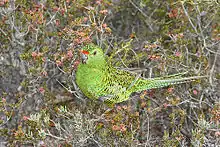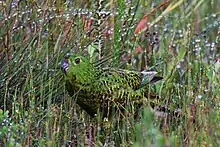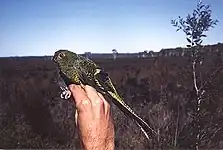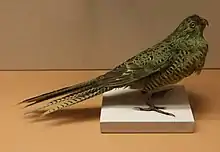| Ground parrot | |
|---|---|
 | |
| Subsp. flaviventris | |
 | |
| Subsp. wallicus | |
| Scientific classification | |
| Domain: | Eukaryota |
| Kingdom: | Animalia |
| Phylum: | Chordata |
| Class: | Aves |
| Order: | Psittaciformes |
| Family: | Psittaculidae |
| Genus: | Pezoporus |
| Species: | P. wallicus |
| Binomial name | |
| Pezoporus wallicus (Kerr, 1792) | |
| Subspecies[3] | |
| |
The ground parrot (Pezoporus wallicus) is a parrot endemic to Australia. It is one of only four ground-dwelling parrots in the world, the others being the closely related night parrot (Pezoporus occidentalis), the Antipodes parakeet (Cyanoramphus unicolor), and the kākāpō (Strigops habroptilus)[4] from New Zealand.
The colouration of the two Pezoporus species and the kakapo is similar – yellowish green with darker barring, somewhat reminiscent of the head and back of the wild-type budgerigar. This is not an indication of a true relationship, however, but either adaptation to a particular lifestyle or a feature retained from ancestral parrots; probably the latter as barred plumage is found all over the family, from the tiny tiger parrots to female cockatiels.
When disturbed, a ground parrot flies swiftly just above the ground before dropping back into the vegetation. The presence of the bird is often only revealed by its characteristic dusk and dawn call, a clear whistling sequence of notes which rise in pitch before fading. It is silent in flight.
It is separated into three subspecies; eastern, western and Tasmanian.
Description

At the species level, the ground parrot is a medium-sized parrot, growing up to 30 cm long and weighing approximately 80 grams. It is distinctive, with grass green plumage, black streaking on the head and hindneck, prominent pale-yellow wing bars and black and yellow barring on the abdomen, thighs and under-tail coverts. The irises are pale yellow, the bill is dark grey and the feet and legs are flesh-pink. They have a distinguishing bright red band above the cere. Males and females appear alike.
Juveniles can be differentiated from adults in that they are slightly smaller, have duller yellow-olive plumage, absent red bands and thicker, bolder markings on the head and breast. When newly fledged, irises are dark grey-brown to brown in colour.
The eastern and Tasmanian subspecies (wallicus and leachi) differ from the western subspecies (flaviventris) in that they have thicker and more prominent black markings on the head, neck and belly.[5]
Taxonomy
This species belongs to genus Pezoporus, which also includes the night parrot (P. occidentalis).This genus belongs to tribe Pezoporini (ground parrots and allies) which includes Neophema and Neopsephotus. It is part of parrot subfamily Platycercinae and family Psittaculidae, the Old World Parrots.[6]
There are currently three recognised subspecies of P. wallicus[3]
Distribution
This species is endemic to Australia. Each subspecies occurs within its own geographically separated distrubution.
Subspecies wallicus occurs in fragmented populations in coastal areas of south-eastern Queensland, New South Wales and Victoria. It is distributed as far north as near Fraser or K'gari Island, and as far south as Portland. It was formerly present in South Australia, but has since gone regionally extinct.[5][8]
Subspecies flaviventris only occurs in two disjunct populations in southern Western Australia, one in Fitzgerald River National Park, the other in Cape Arid National Park and Nuytsland Nature Reserve.[7][9]
Subspecies leachi is endemic to Tasmania, which hosts the largest population of the species as a whole.[1][10]
Habitat
Marshy coastal plain without trees, reed beds with low bushes, restricted to button grass areas; species may depend on naturally occurring fires allowing new growth and renewed settlement by the ground parrot.
Conservation status
Although the species is listed as "Least Concern" on the IUCN Red List of Threatened Species due to the species' large distribution and population size as a whole[1], subspecies P. w. flaviventris has been listed as "Critically Endangered" on the EPBC Act List of Threatened Fauna.[7] It is estimated that there are fewer than 150 birds remaining in the wild, making it one of the rarest parrot species in Australia.[11]
Subspecies P. w. wallicus has been listed as "Vulnerable" on the Biodiversity Conservation Act 2016 in New South Wales and the Nature Conservation (Animals) Regulation 2020 in Queensland. It has also been listed as "Endangered" on the January 2020 list of the National Parks and Wildlife Act 1972 in South Australia, despite being locally extinct. Its last confirmed sighting in South Australia was in Port MacDonnell in January 1945[5]
Breeding

Breeding period from September to January; (one record in March); nest consisted of an excavation in soil 15 cm to 18 cm across and 2 cm (0.75 ins) to 5 cm deep; usually well hidden under small bush or tussock hanging over nest to provide a form of hollow; mostly lined with leaves, grass stalks, fern and small twigs; clutch 3 to 4 eggs; incubation probably 21 days; chicks well camouflaged with thick greyish-black down and protected against cold periods; young remain in nest for two weeks approaching parents for food; fed three times daily; leave nest after three weeks at least disturbance; roost after 25 days outside under tussocks; cannot, however, fly at this point; egg measures 28.1 x 22.2 mm.
References
- 1 2 3 "Pezoporus wallicus (Ground Parrot)". The IUCN Red List of Threatened Species. 2022. Retrieved 4 December 2023.
- 1 2 "First meeting of the Conference of the Parties". CITES.org. Retrieved 4 December 2023.
- 1 2 "Parrots, cockatoos". IOC World Bird List. 15 July 2023. Retrieved 4 December 2023.
- ↑ David, N. & Gosselin, M. 2002. The grammatical gender of avian genera. Bulletin of the British Ornithologists' Club, 122: 257-282
- 1 2 3 "Pezoporus wallicus wallicus — Mainland Ground Parrot, Ground Parrot (eastern)". Australian Government Department of Climate Change, Energy, the Environment and Water. Retrieved 4 December 2023.
- ↑ Leo Joseph; Alicia Toon; Erin E. Schirtzinger; Timothy F. Wright; Richard Schodde (2012). "A revised nomenclature and classification for family-group taxa of parrots (Psittaciformes)" (PDF). Zootaxa. 3205.
- 1 2 3 "Pezoporus flaviventris — Western Ground Parrot, Kyloring". Australian Government Department of Climate Change, Energy, the Environment and Water. Retrieved 4 December 2023.
- ↑ "Western Ground Parrot Project Archived 2006-08-22 at the Wayback Machine". Birds Australia Western Australia. Last modified 26 April 2008.
- ↑ "Western ground parrot - Understanding the habits of a rare and secretive bird (WA)" (PDF). Australian Government Department of the Environment. 2015. Retrieved 4 December 2023.
- ↑ " Archived 2011-03-30 at the Wayback Machine". Ground Parrot Pezeporus wallicus'.
- ↑ "Meet Kyloring, the Western Ground Parrot". Friends of the Western Ground Parrot. Retrieved 4 December 2023.
External links
- World Parrot Trust Parrot Encyclopedia - Species Profiles
